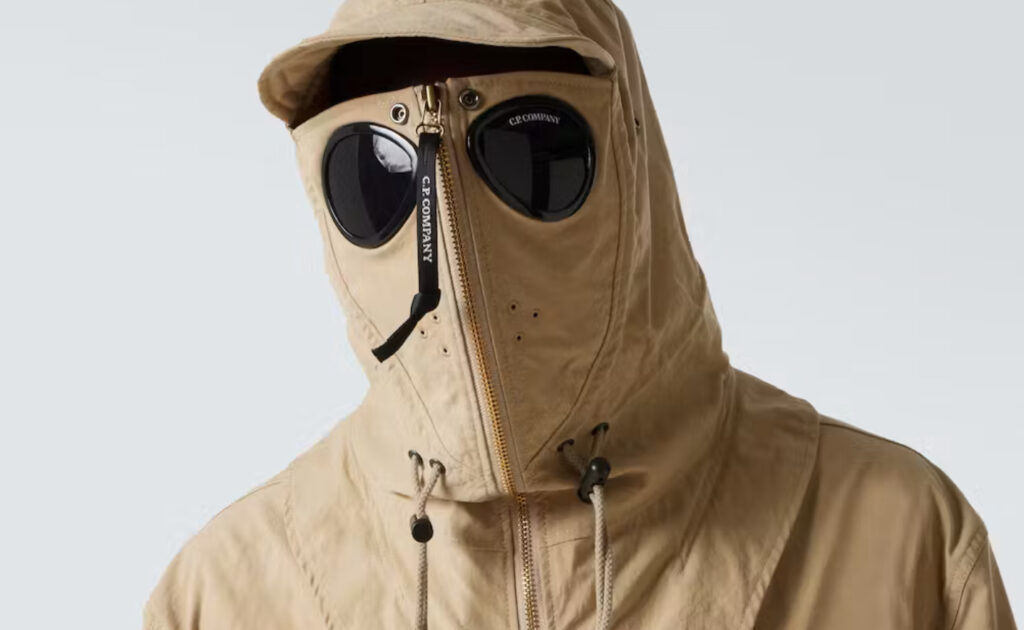

Quiet Innovation with a Loud Legacy
Long before the contemporary techwear explosion—before modular MOLLE straps, cyberpunk shell jackets, and militarized silhouettes flooded runways and Reddit threads—C.P. Company was already laying the groundwork. Founded in 1971 by Massimo Osti, a graphic designer-turned-fashion scientist, the Italian brand has been crafting garments at the intersection of form, function, and futurism for over five decades.
Today, in 2025, C.P. Company remains a lodestar in the world of outerwear innovation. It continues to prove that you don’t need neon tapes or stealth armor aesthetics to be high-tech. Sometimes, the most advanced garment is also the most refined.
Massimo Osti’s Blueprint: Military Meets Meticulous
Massimo Osti’s design ethos was rooted in experimentation. He wasn’t merely making clothes—he was engineering textiles. With a deep fascination for military surplus, Osti infused his work with field-ready practicality. But unlike utilitarian designers driven purely by functionality, he applied the precision and romance of Italian tailoring to create garments that felt tactical without looking like uniforms.
This vision materialized in the earliest versions of what would later be called techwear:
- Garment-dyeing techniques that gave fabric a worn-in, lived texture
- Custom fabric blends like 50 Fili (a fusion of cotton and nylon)
- Functional accessories like lens hoods designed not just for fashion, but utility
These design hallmarks would become the bedrock of C.P. Company’s legacy and would go on to influence brands ranging from Stone Island (also founded by Osti) to today’s modular techwear houses like Acronym and Bagjack.
The 2025 Collection: Tech Refined, Heritage Reimagined
This year’s outerwear lineup sees C.P. Company push even further into the space where heritage meets innovation. While its competitors often veer into hyper-functional minimalism or anime-inspired fantasy gear, C.P. Company opts for something more grounded—yet no less forward-thinking.
Key Technical Features of the 2025 Range:
Nyfoil® Shells
These reflective, foil-backed fabrics offer thermal insulation and visual impact, ideal for transitional city weather. Their subtle shine reflects both heat and aesthetic edge.
Chrome-R GORE-TEX
An advanced evolution of Osti’s legendary Chrome fabric, now integrated with GORE-TEX Infinium™, combining windproof protection with breathability in a lightweight silhouette.
Layered Shell-Liner Systems
Designed with seasonal modularity in mind, these jackets include zip-out liners, concealed venting systems, and internal harnesses—offering wearers maximum customization.
Lens Details & Goggle Hoods
Signature watch-viewer cuffs and goggle hoods remain in circulation—more as cultural signals than raw functionality—but they still serve purpose for riders, travelers, and urban nomads.
Thermoplastic Reissues
Retro styles like the Urban Protection jackets from the late ’90s have been reinterpreted in lightweight, recycled thermoplastics, nodding to both the past and the planet’s future.
Aesthetics of Authority: Techwear Without the Theater
What sets C.P. Company apart in 2025 is its ability to whisper in a world of brands that scream. The silhouettes are streamlined, not spartan. The colors are muted but rich—think smoke green, asphalt gray, rusted bronze. The branding is nearly invisible, save for the unmistakable lens detail, worn now more as a badge of cultural awareness than brand loyalty.
This restraint is deliberate. Where others perform futurism through costuming, C.P. Company achieves it through textile tactility and silhouette mastery. It speaks to a different kind of wearer—one who values narrative, material history, and tactile design over instant impact.
Who Wears C.P. Company?
C.P. Company’s customer base is as evolved as its garments. The brand no longer caters exclusively to outerwear collectors or die-hard Osti archivists. In 2025, the C.P. loyalist may be:
- A photographer cycling through Milan
- A tech founder layering for microclimates in Berlin
- A creative director commuting through Tokyo’s rain-soaked streets
- A former streetwear kid who now values construction over hype
What binds them isn’t occupation—it’s appreciation. They care about how something is made, not just how it looks on Instagram. They know the difference between nylon and Nyfoil®, between trend and legacy.
Legacy and Influence: Osti’s Imprint on the World
The influence of C.P. Company extends far beyond its retail offerings. Its technical innovations have seeped into luxury, streetwear, and sportswear. Brands like Stone Island (also birthed by Osti), Nike ACG, and even Louis Vuitton’s FW23 outerwear line owe a creative debt to the techniques pioneered in C.P.’s Italian labs.
Perhaps more significantly, C.P. Company’s approach to fashion as function-first storytelling has paved the way for fashion houses to treat textiles like software—iterative, responsive, endlessly hackable.
The Street-to-Sartorial Bridge
Today, techwear is often split into binary: either hyper-styled, cyber-core silhouettes or mil-spec dystopian wear. C.P. Company stands in a rare middle ground, proving that you don’t have to dress like a spec-ops operator or a digital ninja to be part of the techwear revolution.
Instead, C.P. offers a vision that fuses technical intuition with refined restraint. Their jackets don’t demand to be seen—but they reward those who do.
The Original Visionary Still Leads
In 2025, C.P. Company remains the quiet authority in outerwear innovation. Its legacy is not just in garments, but in how we now think about functionality, fabric, and fashion as integrated systems.
Massimo Osti may have passed, but his vision endures: that the future of fashion is not just about looking forward—but building forward, material by material, stitch by stitch.
No comments yet.








